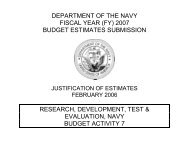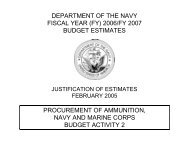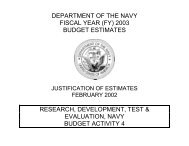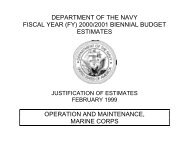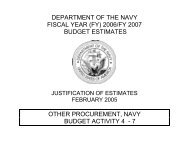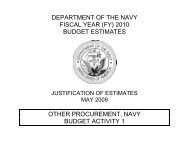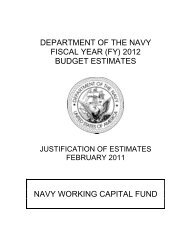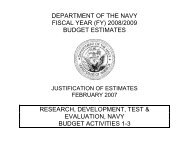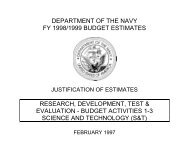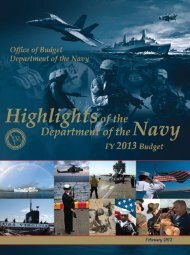Budget Highlights Book - DON FM&C Website - U.S. Navy
Budget Highlights Book - DON FM&C Website - U.S. Navy
Budget Highlights Book - DON FM&C Website - U.S. Navy
You also want an ePaper? Increase the reach of your titles
YUMPU automatically turns print PDFs into web optimized ePapers that Google loves.
February 2010Rebalancing Investment to Meet Global RequirementsThe Distributed Common Ground System – <strong>Navy</strong> (DCGS‐N) is the <strong>Navy</strong>’s portionof the defined DoD DCGS ISR systems architecture. Data collected from satellites,aircraft, ships or submarines; or contained in intelligence databases from allintelligence producers will be shared across a joint enterprise. DCGS‐N FY 2011funds support the procurement and installation of five block one systems (for oneshore command, two carriers, and two amphibious ships). These DCGS‐N systemswill replace the currently fielded Joint Services Imagery Processing System – <strong>Navy</strong>(JSIPS‐N) and Joint Fires Network (JFN) systems.Shipboard information warfare equipment includes radio receivers, managementsystems, recorders, distribution systems, antennas and related equipment. The <strong>Navy</strong>uses this equipment to exploit adversarial transmissions across the entireelectromagnetic spectrum to better anticipate threats to <strong>Navy</strong> assets. Ship SignalExploitation Equipment (SSEE) Increments E and F are tactical cryptological andinformation operations exploitation and attack systems fielded and in development.Increment E is a highly sensitive automated electronic support measure andelectronic attack system that provides automatic signal acquisition, directionfinding, target geo‐location and Information Operations capability fielded on overforty surface combatants. FY 2011 funding will support the low rate initialproduction installations and the procurement of ten full rate production SSEEIncrement F systems. Funding will also be used to expand existing processingcapability to allow collection of the newest high priority threat signals outside thefrequency range of existing systems.The Submarine Communications program’s mission is to create a common,automated, open system architecture radio room for all submarine classes, bringingnetwork‐centric warfare to the submarine force. The program addresses the uniquedemands of submarine communications, obsolescence issues, and higher data raterequirements. It also procures and installs antenna modifications to support newsatellite communications and data link capability. The common submarine radioroom is a completely interoperable communications system operating within theFORCEnet architecture, which provides reliable two‐way, modern, IP connectivityto joint and combined forces. This evolutionary system achieves unmatchedcapability, cost reduction, and future technology integration via a multimedia,circuit sharing, and Commercial Off‐The‐Shelf (COTS) based open architecture thatserves as the shipboard automated communications control system. Procurementfunding supports the transition of the Los Angeles class radio room to the commonsubmarine radio room and upgrades to Seawolf, Virginia and Ohio class submarinesradio rooms.5–26 FY 2011 Department of the <strong>Navy</strong> <strong>Budget</strong>



